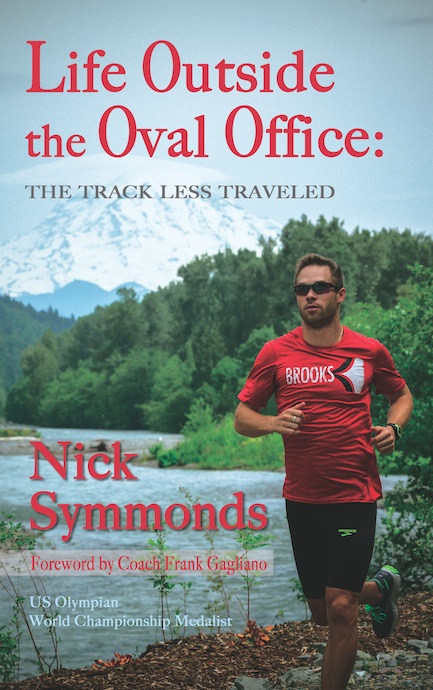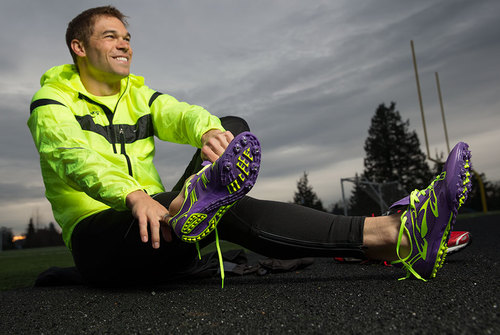Q&A WITH NICK SYMMONDS ON HIS NEW BOOK
By Chris Lotsbom, @ChrisLotsbom
(c) 2014 Race Results Weekly, all rights reserved
(29-Sep) — Last week, Race Results Weekly spent some time speaking with two-time Olympian and 2013 IAAF World Championships silver medalist Nick Symmonds. Speaking by phone from Yosemite National Park, Symmonds discussed his new book “Life Outside the Oval Office: The Track Less Traveled,” which will come out next month.

The book, published by Cool Titles, is a first-person account of Nick’s career, taking readers from his days as a high schooler in Idaho, through college at Willamette University, and to the present as a Brooks Beast athlete. With each chapter Symmonds tells a story, shedding light on the challenges and obstacles faced at each stage of his life. His no-holds-barred, emotion-filled prose grip the reader and captivates their attention from the opening chapter.
Symmonds gives an insiders look at everything from his life as a professional athlete traveling the international track circuit, to his business background and what motivates him to be the best. A variety of topics are discussed in depth, are circling around Symmonds’s coming of age story.
A great read, “Life Outside the Oval Office: The Track Less Traveled” pulls the reader in from the get-go, as Symmonds opens up like never before.
Speaking with Symmonds, we discussed the book’s development and his thoughts as it gets ready to hit shelves soon.
RACE RESULTS WEEKLY: First off, take me through the book writing process. Was it what you expected, or a bit more challenging?
NICK SYMMONDS: Originally I approached the publisher with the idea of using a ghost writer, but they had read some of my blogs and were impressed with my writing enough for them to say they wanted me to write it myself. They connected me with a really good editor and I kind of knew that I couldn’t write 50 pages, I just couldn’t wrap my mind around it. So I really wrote it more as twelve different stories or chapters of my life. With the help of the editor, I was able to put that all in chronological order and add some links to create a more smoothly flowing novel or book here…
It was a daunting task and I really found that I had to apply a lot of the goals and principles in training to writing, and just chip away at it one piece at a time.
RRW: Why did you chose to write a book while you’re still in the middle of your career? A majority of athletes wait until they are done competing.
SYMMONDS: I know certainly most people would write a book when they were finished, but I thought it was a good opportunity here to tell some stories and shed some light on some things I wanted to shed light on while I was still in the sport and still continuing to run and have that platform. Certainly there will be more stories to tell and I can always go back and write another book. But I thought this is something I wanted to do for a while, and it is kind of rare for an athlete to write their autobiography and do so while they were still competing.
RRW: Did you look at any other athletes as inspiration?
SYMMONDS: My favorite autobiography is “Open” by Andre Agassi. I just love that read and he wrote his at the end of his career. Of course a lot of things he said in his autobiography he couldn’t say during his career. I kind of wrote mine in that style. I had to tone things down just a little bit in order to appeal to a broader market and to protect myself legally in the middle of my career. But my editor and publisher were very helpful in that process. But I think we were able to accomplish and tell the stories I wanted to tell in a way that is reader friendly.
RRW: Your book goes beyond the track and behind the scenes of the industry. Can you talk about that, really stepping outside the oval office as your title entails?
SYMMONDS: The first half of the book is really how I got to where I am today, how I got to professional track and field, really. The priorities that I had as a youth, in high school and in college, I never thought I was going to run professionally until the day I graduated from college. That’s when it kind of clicked for me. I was a Division III kid, and I went to Division III so I could join a fraternity, party every weekend and live my life a little bit. In the book it discusses what many college kids do. In Oregon, that’s hanging out with girls, smoking weed and drinking beers. That was my life, and it wasn’t until my best friend and mentor Sam Lapray came to my side and said, ‘Hey I believe in you and I believe you have what it takes to be an Olympian…’
The second half of the book is kind of a little bit of everything from professional track and field. A behind the scenes look at the lifestyle of track athletes, what the circuit is like. It talks a little bit about the publicity stunts I pulled and why I pulled them, from dating Paris Hilton to the beer mile, and why those were strategically chosen and why we chose the times that we did for financial reasons. I’ve always prided myself as a businessman as well as an athlete, and I like to run Nick Symmonds, LLC, as a business. That’s why we call it “Outside the Oval Office.” It’s my office and I really do think of myself as the CEO of my business.
RRW: Your book is really a coming of age story. What was it like to look back and reflect on the entire journey?
SYMMONDS: It brought out a lot of emotion. I tried to write it and go back and connect with the high school aged Nick or the college aged Nick and really remember what my priorities were at the time. For some people it might be difficult to read because I’m really trying to play up my priorities that I had as a high school athlete, the insecurities that I had, or the priorities I had in college. People will think ‘Well this kid’s a real asshole.’ Well, I was an asshole, and most college kids were. My priorities were that of most 18- to 22-year-olds. But if you stick with me through it, you’ll understand why I felt that way at the time and how it allowed me to accomplish things I needed to accomplish, and ultimately how I’ve come out the back end of it as a 30-year-old who is really mature and grown to appreciate the important things in life as opposed to the more trivial things.
RRW: Looking back on the whole process, from day one when you had the idea to write a book until now, when you’re on tour and it is about to be released, what are your thoughts?
SYMMONDS: It’s been a really wild ride. I liken it to running quite a bit. If I was to sum it up in one word I’d just say cathartic because when you tell a story and you put it all out there, it really is emotion invoking and really was satisfying to go back and kind of relive all that. More than anything it helped me gain an appreciation for what I’ve a
ccomplished because as professional runners, we’re never satisfied with what we’ve done. We always want more and always want to be better. That’s led to me being successful on the track but not necessarily satisfied or happy with what I’ve accomplished. Looking back at how much work we put in and how hard my whole team worked, from Sam Lapray to Mark Rowland to my folks, everybody else, I’m just very, very proud of what we’ve accomplished.
RRW: Finally, we’d be remiss if we didn’t ask about your training. Has training been good and are you back healthy?
SYMMONDS: Training has been really, really good. I took that break after the injury and we decided not to race. We could have put together a race season in the second session but it would have been rushing back for a couple races which just seemed pointless in a non-Olympic and non-Championship year. I put in 12 weeks of training and found that I actually got really fit really quickly…
I will start another twelve week training cycle when I get back [from time at Yosemite] which will take me through the new year… I’m well rested, and if I can stay healthy I’ll have the best base of my life going into 2015 and hopefully that opens up some opportunities. I think that I would just like to continue to train hard and put the miles in, but if I’m healthy and really get strong, I’d like to do some things that I’ve always wanted to do but never quite had the time to prepare for. Maybe a 5000m on the track in early spring and really try to attack the 1500m because I think I have a lot of potential that I haven’t quite realized in that event.
RRW: And of course, the Beer Mile Championships are coming up in December…
SYMMONDS: Well that’ll be my next race on the track!
Author

Larry Eder has had a 52-year involvement in the sport of athletics. Larry has experienced the sport as an athlete, coach, magazine publisher, and now, journalist and blogger. His first article, on Don Bowden, America's first sub-4 minute miler, was published in RW in 1983. Larry has published several magazines on athletics, from American Athletics to the U.S. version of Spikes magazine. He currently manages the content and marketing development of the RunningNetwork, The Shoe Addicts, and RunBlogRun. Of RunBlogRun, his daily pilgrimage with the sport, Larry says: "I have to admit, I love traveling to far away meets, writing about the sport I love, and the athletes I respect, for my readers at runblogrun.com, the most of anything I have ever done, except, maybe running itself." Also does some updates for BBC Sports at key events, which he truly enjoys. Theme song: Greg Allman, " I'm no Angel."
View all posts



















